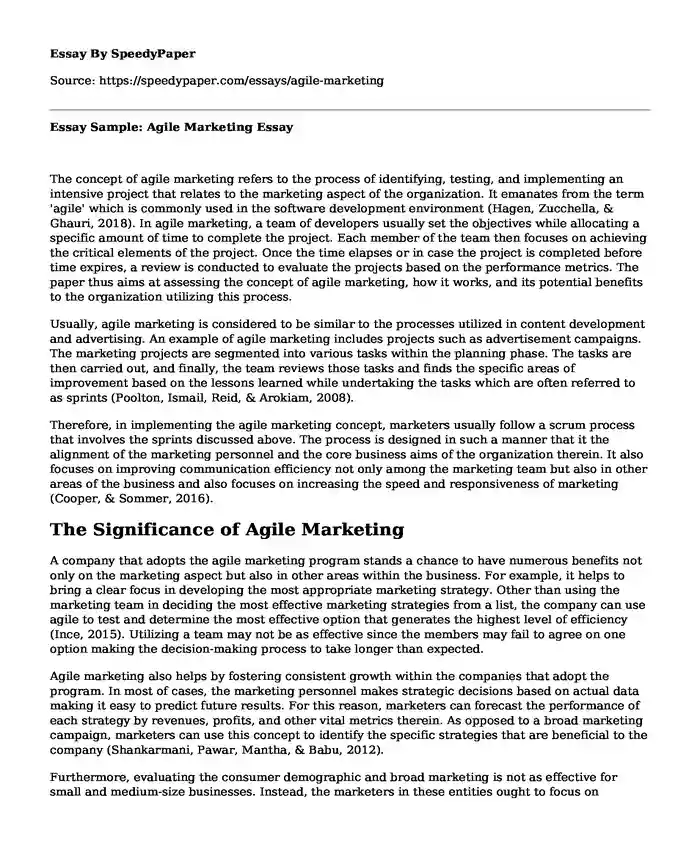The concept of agile marketing refers to the process of identifying, testing, and implementing an intensive project that relates to the marketing aspect of the organization. It emanates from the term 'agile' which is commonly used in the software development environment (Hagen, Zucchella, & Ghauri, 2018). In agile marketing, a team of developers usually set the objectives while allocating a specific amount of time to complete the project. Each member of the team then focuses on achieving the critical elements of the project. Once the time elapses or in case the project is completed before time expires, a review is conducted to evaluate the projects based on the performance metrics. The paper thus aims at assessing the concept of agile marketing, how it works, and its potential benefits to the organization utilizing this process.
Usually, agile marketing is considered to be similar to the processes utilized in content development and advertising. An example of agile marketing includes projects such as advertisement campaigns. The marketing projects are segmented into various tasks within the planning phase. The tasks are then carried out, and finally, the team reviews those tasks and finds the specific areas of improvement based on the lessons learned while undertaking the tasks which are often referred to as sprints (Poolton, Ismail, Reid, & Arokiam, 2008).
Therefore, in implementing the agile marketing concept, marketers usually follow a scrum process that involves the sprints discussed above. The process is designed in such a manner that it the alignment of the marketing personnel and the core business aims of the organization therein. It also focuses on improving communication efficiency not only among the marketing team but also in other areas of the business and also focuses on increasing the speed and responsiveness of marketing (Cooper, & Sommer, 2016).
The Significance of Agile Marketing
A company that adopts the agile marketing program stands a chance to have numerous benefits not only on the marketing aspect but also in other areas within the business. For example, it helps to bring a clear focus in developing the most appropriate marketing strategy. Other than using the marketing team in deciding the most effective marketing strategies from a list, the company can use agile to test and determine the most effective option that generates the highest level of efficiency (Ince, 2015). Utilizing a team may not be as effective since the members may fail to agree on one option making the decision-making process to take longer than expected.
Agile marketing also helps by fostering consistent growth within the companies that adopt the program. In most of cases, the marketing personnel makes strategic decisions based on actual data making it easy to predict future results. For this reason, marketers can forecast the performance of each strategy by revenues, profits, and other vital metrics therein. As opposed to a broad marketing campaign, marketers can use this concept to identify the specific strategies that are beneficial to the company (Shankarmani, Pawar, Mantha, & Babu, 2012).
Furthermore, evaluating the consumer demographic and broad marketing is not as effective for small and medium-size businesses. Instead, the marketers in these entities ought to focus on understanding consumer buying behavior as well and understanding the intuitive elements that influence the buying decisions of the target customers. It this means that marketers need to understand customer needs and preferences (Poolton, Ismail, Reid, & Arokiam, 2008). Through agile marketing, these marketers can fulfill this since this concept provides adequate materials and tests that allow the entities to maximize good communication with the clients. In this case, it makes a small marketing audience to be more profitable.
In conclusion, it is evident that agile marketing is very vital in today's marketing world. Following the numerous benefits that it accrues to the marketing field and other areas, it is thus essential that companies consider embracing this technique as a significant tool for enhancing their operational efficiency.
References
Cooper, R., & Sommer, A. (2016). Agile-stage-gate: New idea-to-launch method for manufactured new products is faster, more responsive. Industrial Marketing Management, 59, 167-180.
Hagen, B., Zucchella, A., & Ghauri, P. (2018). From fragile to agile: marketing as a key driver of entrepreneurial internationalization. International Marketing Review.
Ince, C. (2015). Approaches and benefits for adopting agile methods. INSIGHT, 18(3), 18-20.
Poolton, J., Ismail, H., Reid, I., & Arokiam, I. (2008). Implementation of an agile marketing approach for the manufacturing-based SME. International Journal Of Entrepreneurship And Small Business, 6(2), 264.
Shankarmani, R., Pawar, R., S. Mantha, S., & Babu, V. (2012). Agile methodology adoption: benefits and constraints. International Journal Of Computer Applications, 58(15), 31-37.
Cite this page
Essay Sample: Agile Marketing. (2022, Nov 03). Retrieved from https://speedypaper.net/essays/agile-marketing
Request Removal
If you are the original author of this essay and no longer wish to have it published on the SpeedyPaper website, please click below to request its removal:
- Literary Essay on the Raven by Edgar Allan Poe
- Theranos - Free Essay Example
- Finance Essay Sample for Free: Evaluate Pay Equity
- Free Essay on Birth Experiences of Somali Women in Canada Who Had Undergone Female Genital Mutilation
- Essay Sample: Marriage Analysis in Romeo and Juliet and Much Ado about Nothing
- Free Paper Sample on Gender Issues in Family Therapy
- Essay Sample on Modern-Day Support for Alfred Alder's Theory
Popular categories





